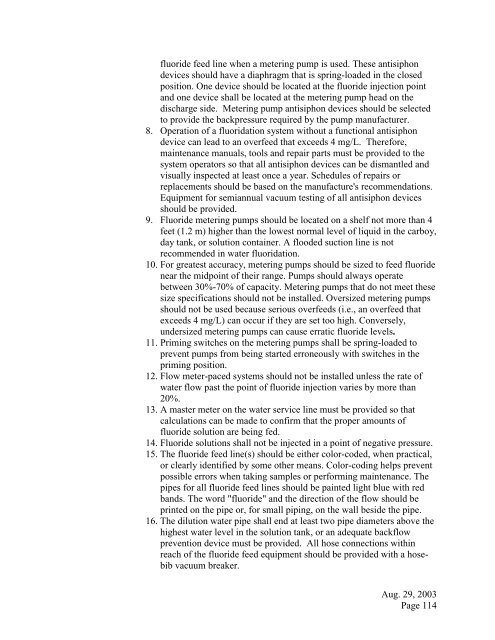Design Guide for Community Water Systems - The Water, Sanitation ...
Design Guide for Community Water Systems - The Water, Sanitation ...
Design Guide for Community Water Systems - The Water, Sanitation ...
Create successful ePaper yourself
Turn your PDF publications into a flip-book with our unique Google optimized e-Paper software.
fluoride feed line when a metering pump is used. <strong>The</strong>se antisiphondevices should have a diaphragm that is spring-loaded in the closedposition. One device should be located at the fluoride injection pointand one device shall be located at the metering pump head on thedischarge side. Metering pump antisiphon devices should be selectedto provide the backpressure required by the pump manufacturer.8. Operation of a fluoridation system without a functional antisiphondevice can lead to an overfeed that exceeds 4 mg/L. <strong>The</strong>re<strong>for</strong>e,maintenance manuals, tools and repair parts must be provided to thesystem operators so that all antisiphon devices can be dismantled andvisually inspected at least once a year. Schedules of repairs orreplacements should be based on the manufacture's recommendations.Equipment <strong>for</strong> semiannual vacuum testing of all antisiphon devicesshould be provided.9. Fluoride metering pumps should be located on a shelf not more than 4feet (1.2 m) higher than the lowest normal level of liquid in the carboy,day tank, or solution container. A flooded suction line is notrecommended in water fluoridation.10. For greatest accuracy, metering pumps should be sized to feed fluoridenear the midpoint of their range. Pumps should always operatebetween 30%-70% of capacity. Metering pumps that do not meet thesesize specifications should not be installed. Oversized metering pumpsshould not be used because serious overfeeds (i.e., an overfeed thatexceeds 4 mg/L) can occur if they are set too high. Conversely,undersized metering pumps can cause erratic fluoride levels.11. Priming switches on the metering pumps shall be spring-loaded toprevent pumps from being started erroneously with switches in thepriming position.12. Flow meter-paced systems should not be installed unless the rate ofwater flow past the point of fluoride injection varies by more than20%.13. A master meter on the water service line must be provided so thatcalculations can be made to confirm that the proper amounts offluoride solution are being fed.14. Fluoride solutions shall not be injected in a point of negative pressure.15. <strong>The</strong> fluoride feed line(s) should be either color-coded, when practical,or clearly identified by some other means. Color-coding helps preventpossible errors when taking samples or per<strong>for</strong>ming maintenance. <strong>The</strong>pipes <strong>for</strong> all fluoride feed lines should be painted light blue with redbands. <strong>The</strong> word "fluoride" and the direction of the flow should beprinted on the pipe or, <strong>for</strong> small piping, on the wall beside the pipe.16. <strong>The</strong> dilution water pipe shall end at least two pipe diameters above thehighest water level in the solution tank, or an adequate backflowprevention device must be provided. All hose connections withinreach of the fluoride feed equipment should be provided with a hosebibvacuum breaker.Aug. 29, 2003Page 114
















